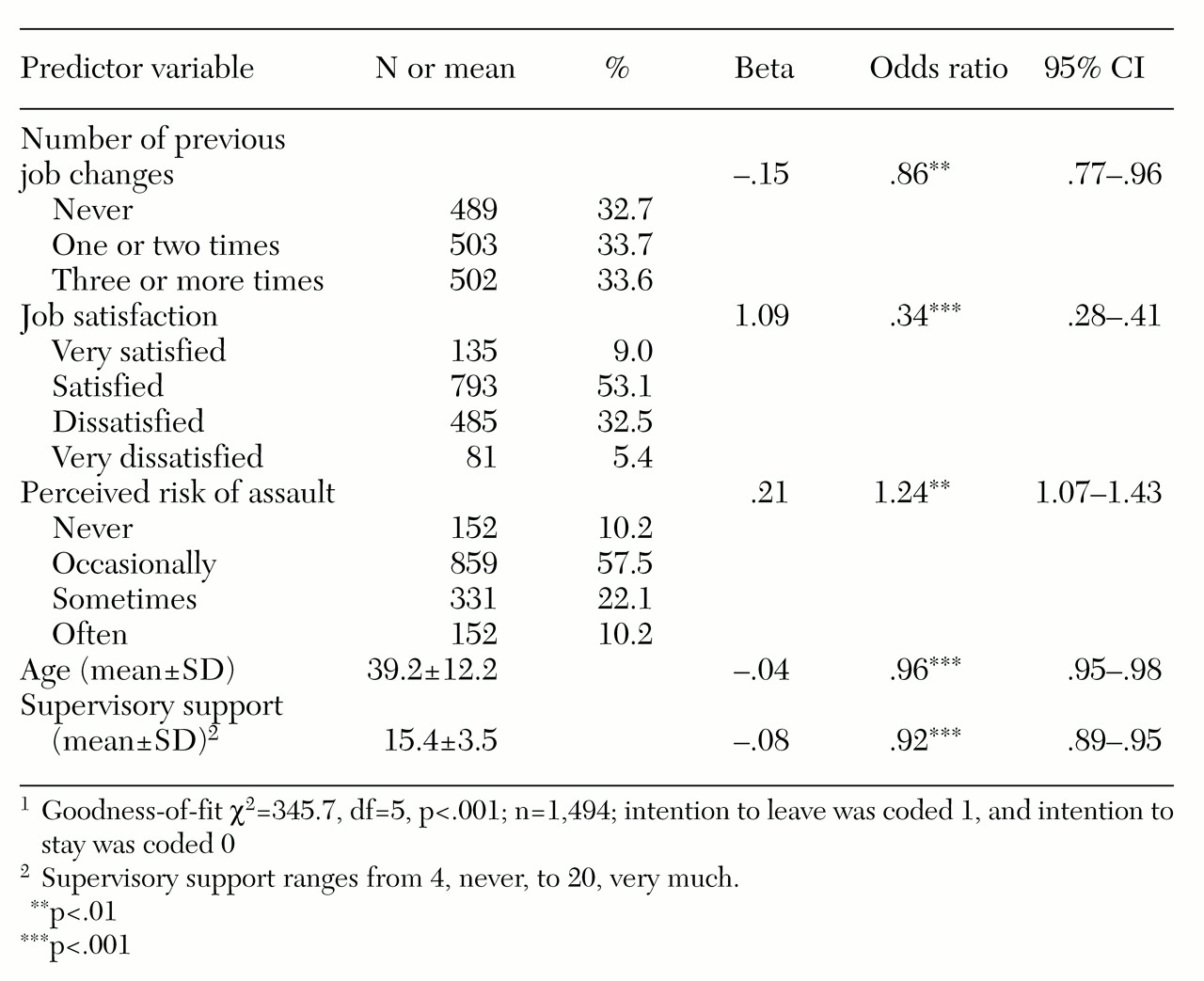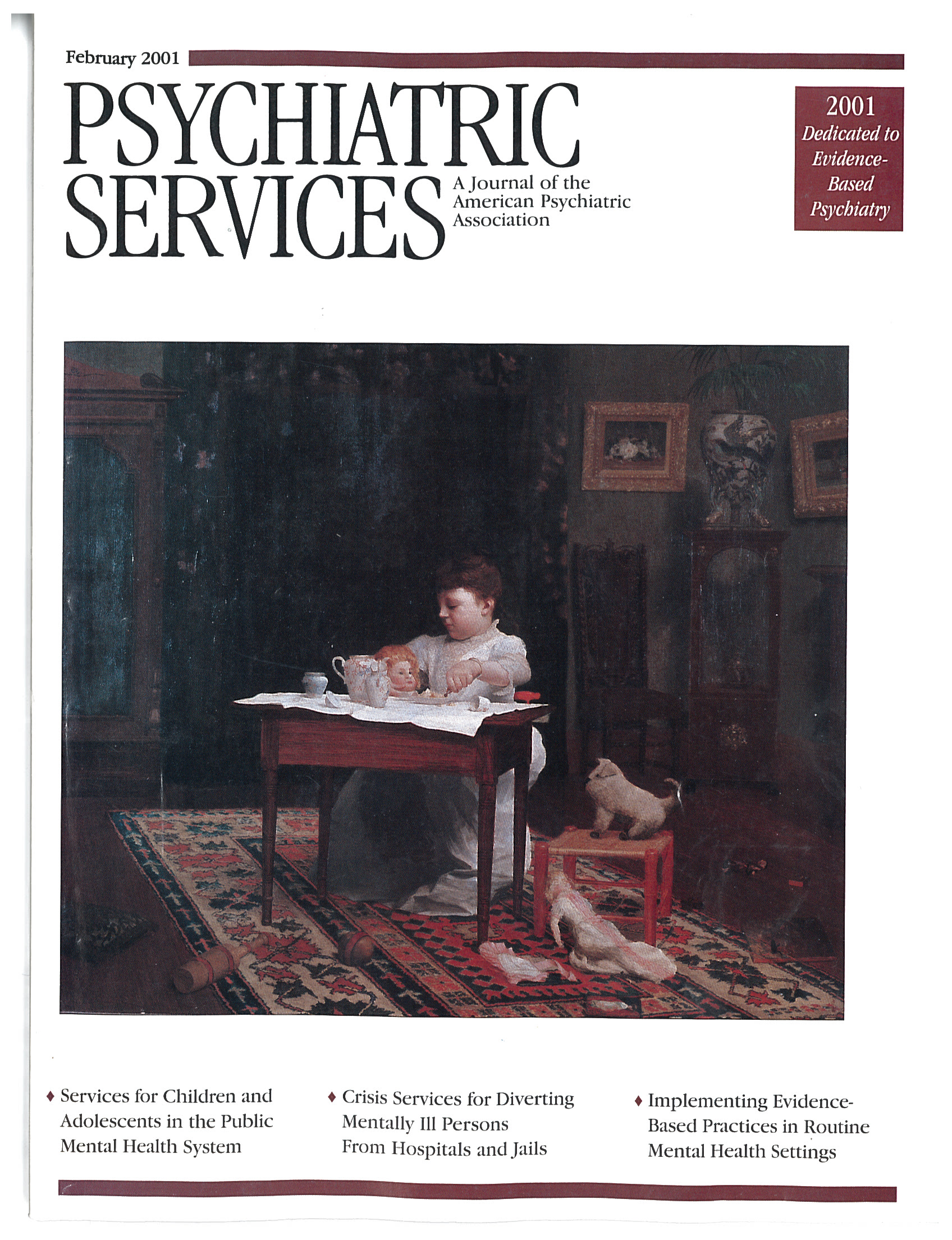Turnover of highly skilled nurses is a problem for many psychiatric hospitals. Nurses are the frontline professional staff for psychiatric patients; without them, the provision of high-quality care is difficult. When a staff member develops the intention to leave a job, it becomes the strongest direct predictor of actual departure (
1). By examining predictors of intention to leave, hospital administrators may be able to take steps to retain skilled nursing staff.
We examined several factors related to nurses' intention to leave their job. One of them was nurses' perception of the risk of assault by patients. Assault has been a concern for staff in psychiatric hospitals (
2), and as primary caregivers, nurses have been at greatest risk of assault among staff (
3). Job satisfaction was also examined, as its strong relationship with retention is often discussed in the literature (
1,
4,
5). A negative relationship has been reported between supervisory support and turnover in nonpsychiatric settings (
6). We included supervisory support in our study to see whether the negative relationship is also true in psychiatric settings.
Our research questions were as follows: What proportion of nurses in psychiatric hospitals intend to leave their job? Are their intentions related to their perceptions of other job opportunities and to the number of times they have previously changed jobs? How does the perceived risk of assault on the job influence nurses' intention to leave? Could job satisfaction and supervisory support enhance retention?
Methods
The study was conducted in Japan between September and November 1998. Of the 108 member hospitals of the Fukuoka Association of Psychiatric Hospitals, 27 participated in the study. The number of beds ranged from 60 to 500, and the patient-to-staff ratio was 3 to 1 on average. We asked all the licensed nurses in these facilities, excluding nurse managers and nurse aides, to respond anonymously to our questionnaire. Of 1,952 nurses, 1,494 (76.5 percent) returned completed questionnaires. The mean±SD age of respondents was 39.2±12.2 years, and 1,228 (82.2 percent) were females.
The National Institute for Occupational Safety and Health (NIOSH) job stress questionnaire (
7) was used to measure perceived risk of assault, job satisfaction, and supervisory support. Demographic data and information about respondents' perceptions of other job opportunities and number of previous job changes were also obtained. The questionnaire was translated into Japanese and its reliability and validity examined (
8).
To focus on our research questions and to reduce the burden for participants, we used selected items from four components of the NIOSH questionnaire—risks in the psychosocial work environment, job dissatisfaction, employment opportunities, and supervisory support. Actual experience of assault within the past year and perceived risk of assault were rated on 4-point scales from 1, never, to 4, often. Job satisfaction was rated as either satisfied or dissatisfied. Supervisory support was assessed by totaling the scores of four items that were each rated on a 5-point scale—for example, "How easy is it to consult with your supervisor?" Each subscale had acceptable reliability, with alpha coefficients ranging from .73 to .84 (
8).
The questionnaire assessed respondents' intention to leave by asking them to indicate whether they "intend to stay on the job" or "intend to leave the job."
For statistical analysis of categorical data, we used chi square tests, and for comparison of continuous variables, we used t tests. To estimate the association between intention to leave and related variables, we used Kendall's tau b. We applied the Bonferroni correction to keep the type I error rate below an alpha level of .05. Logistic regression analyses were carried out to identify predictors of intention to leave the job.
Results
Of the 1,494 participants, 662 (44.3 percent) reported that they intended to leave their job. Sixty-eight participants (4.6 percent) felt that it would be easy to find another job, whereas 855 (57.2 percent) felt that it would be difficult; 571 (38.2 percent) were not sure. A third of participants had never left a job, a third had experienced one or two job changes, and a third had experienced three or more job changes.
Nurses who intended to leave their job were significantly more likely to feel that they had other opportunities elsewhere (Kendall's tau b=-.063, p=.005) and reported fewer previous job changes (Kendall's tau b=-.147, p<.001). Nurses who had supervisory support were significantly less likely to say they intended to leave than those who did not have support (Kendall's tau b=-.163, p<.001).
On average, the nurses who intended to leave their job were significantly younger than those who did not (mean±SD, 35.8±11.4 versus 41.9± 12.3; t=9.9, df=1,492, p<.001). Time in current job was significantly longer among those intending to stay (mean=6 years; third quartile minus first quartile, Q3-Q1=9 years) than among those intending to leave their job (mean=5 years; Q3-Q1=7 years; z=3.1, p=.002).
A total of 635 nurses (41.3 percent) had experienced assault within the past year. As for their perceptions of the risk of assault, 10.2 percent never felt at risk of assault, 57.5 percent felt at risk occasionally, 22.1 percent sometimes, and 10.2 percent often.
Although we examined the patient-to-staff ratio and stress level as organizational and personal factors, respectively, we found no significant differences in these measures between respondents intending to leave and those intending to stay.
The results of the logistic regression analysis are summarized in
Table 1. Younger age, fewer previous job changes, less supervisory support, lower job satisfaction, and higher perceived risk of assault were significant predictors of nurses' intention to leave their job.
Discussion
In this study, almost half of the nurses surveyed (44.3 percent) intended to leave their job—a higher rate than we expected. These results are of concern because they suggest dissatisfaction with the workplace and potentially detrimental influences on the quality of care delivered to patients.
A large proportion of respondents (89.8 percent) perceived some risk of assault. The characteristics of Japanese psychiatric services, such as the mixing of forensic patients with chronic and acute patients, may contribute to high rates of assault (
9). Interestingly, actual experience of assault was not a significant predictor of intention to leave, although perceived risk of assault was. This finding suggests that measures designed to reduce perceived risk may be helpful in reducing staff turnover.
As has been found in previous studies (
1,
5), higher job satisfaction was inversely associated with intention to leave in our study. Furthermore, nurses were less likely to intend to leave their job if they felt supervisory support.
The FADE method of total quality management—focus, analyze, develop, and execute—has been reported to be effective in reducing inpatient violence. Through analysis of special incident reports, violence problems and possible background reasons were identified, and then prevention measures were planned and executed (
10). It may be possible to predict risk factors by an appropriate organizational approach. The first step in preventing staff turnover is to improve working conditions, including ensuring a safe working environment, increasing job satisfaction, and training supervisors to support their staff.
There are limitations to this study. We did not study actual turnover; thus we examined not behavioral but intentional measures. Also, the severity of workplace assaults was not assessed.
Conclusions
We found that the perceived risk of workplace assault among staff was related to their intention to leave their job, and that job satisfaction and support from supervisors might defuse intentions to leave. In addition, organizational efforts are necessary to improve working conditions for staff and consequently to improve the quality of patient care.
Acknowledgments
This work was supported by a comprehensive research on disability, health, and welfare grant from the Japan Ministry of Health and Welfare and by an international joint research grant from Pfizer Health Research Foundation.


